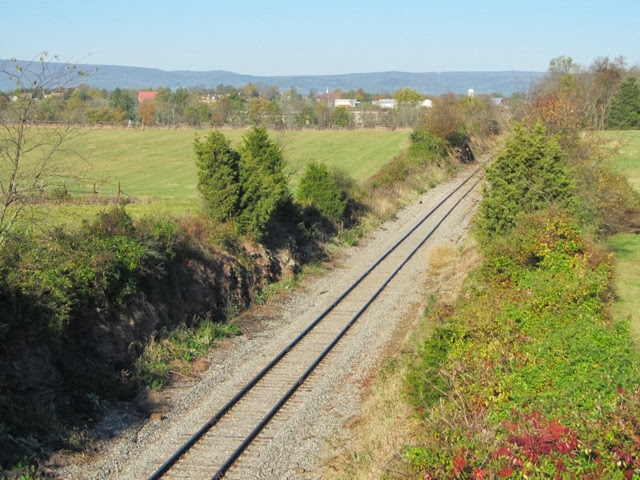Gettysburg National Military Park
Eternal Light Peace Memorial
McPherson Ridge - July 1, 1863
General Reynolds was killed in battle. Giving orders to his men he turned to say, "Forward men forward for God's sake and drive those fellows out of those woods", and was then shot in the back of the head.
In Gettysburg the horses tell a story; 2 feet up = died in battle, 1 foot up = wounded in battle, and all four feet on the ground = survived the Battle of Gettysburg.
Underneath this monument of the 149th Pennsylvania Infantry (Bucktail Brigade) it reads:
CARRIED INTO ACTION 460
Killed or mortally wounded 66 Wounded 159
Captured or missing 111 Total 336
The railroad cut where Confederate soldiers marched only to become "sitting ducks" for the Union army. About 300 Confederate soldiers surrendered after being trapped in the unfinished cut.
In 1996 during a hard rain storm a skeleton washed out in this cut, it couldn't be identified but it was determined to be a young right- handed male who was later reburied in the Soldiers' National Cemetery.
Seminary Ridge
The Lutheran Theological Seminary cupola afforded a comprehensive view of the battlefield for Brigadier General Buford as he awaited the approaching Confederate army on July 1.
Memorials in the park are placed where men fought and where they died, so they can be found in woods, orchards, hillsides, wheat fields, rock outcroppings, anywhere...
When the first day ended, the Confederates held the upper hand. Lee decided to continue the offensive, pitting his 70,000 men against Meade's Union army of 93,000.
North Carolina Memorial - July 2, 1863
Cannons tell another story; they are placed where they would have been during the battle. These belonged to North Carolina and are found on both sides of their state memorial.
Early in the day the Confederate Army positioned itself on high ground here along Seminary Ridge, through town, and north of Cemetery and Culps hills.
Virginia Memorial
General Robert E. Lee, Confederate commander, sits atop the Virginia Memorial. Notice his horses feet.
This large open field, that Lee looks out on, is where the last Confederate assault of the battle took place, known as "Pickett's Charge".
Little Round Top
Scott atop a monument on Little Round Top looking out over the battlefield.
Union Breastworks
On the evening of July 2nd the Union Army dropped rocks into place as they prepared for the battle the next morning. They needed the protection from Confederate sharpshooters holed-up in the Devil's Den.
Devil's Den
Looking down on Devil's Den from Little Round Top.
Late in the afternoon of July 2, Confederates captured Devil's Den and the ridge above here in a bloody struggle - it then became a nest of Confederate sharpshooters who took aim at Union officers and men on Little Round top. The sniping continued until the end of the battle on July 3.
The Wheatfield
Charge and counter charge left this field and nearby woods strewn with 4,000 dead and wounded. This is the spot where the enormity of the war hit me, I can't even imagine the events that took place that day.
Rose Farm
The Union line extended from Devil's Den to here, The Peach Orchard. Federal cannons bombarded Confederate forces crossing the Rose Farm towards the Wheatfield until about 6:30 pm, when Confederate attacks overran this position.
Wheatfield on the Rose Farm side.
This is a horse trail in the park but it's how I imagine the road looked as Confederate soldiers climbed over the fence, ran across the open road, and climbed the fence again on their charge up Cemetery Hill.
Pennsylvania Memorial
Union artillery held the line alone here on Cemetery Ridge late in the day as Meade called for infantry to strengthen and hold the center of the Union position.
By day's end, both flanks of the Union army had been attacked and both held, despite losing ground. Meade, anticipating an assault on the center of his line, determined that his army would stay and fight.
The Angle on Cemetery Ridge - July 3, 1863
The fence line below was guarded all night long by Union soldiers because they knew that the Confederate army would have to cross the road to attack the 7,000 Union troops posted around the Copse of Trees, The Angle, and the Brian Farm all on Cemetery Ridge.
Late in the afternoon, after 2 hours of cannon fire, the Union Army repulsed the bulk of the 12,000 man "Pickett's Charge" against their center. This was the climatic moment of the battle. Lee's men began retreating on July 4th.
General Meade
Only 3 days after assuming command of the Union Army of the Potomac, Major General George Meade faced Robert E. Lee in perhaps the greatest battle of the Civil War. From this spot on Cemetery Ridge he observed the closing moments of the battle and encouraged his troops.
Total casualties (killed, wounded, captured, and missing) for the three days of fighting were 23,000 for the Union army and 28,000 for the Confederate army.
Dobbin House
Dobbins House was built in 1776 and is now an inn, fine dining restaurant, and tavern. Scott and I ate in the basement tavern that was rich in history with stone walls, fireplaces, and a hand-carved bar. The servants wore period clothing right down to their tie-on pockets!
In the mid-1800's, a secret crawl space was used as a stop on the Underground Railroad.

















































